/ Home / Attractions / Via LaietanaPrint version
Via Laietana
.JPG.medium.jpg) .JPG.medium.jpg) .JPG.medium.jpg) .JPG.medium.jpg) .JPG.medium.jpg)
|
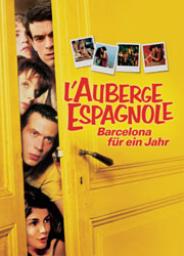 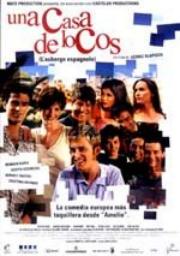
|
Historic information
The Via Laietana was expanded in the first decade of the last century following the signature of an agreement between the municipal council and the Banco Hispano Colonial. The project, known as “La Reforma”, was the first redevelopment scheme in a city still dotted with narrow medieval streets, and was instrumental in cleaning up its old quarter. The Via Laietana was based on the idea by the town planner Ildefons Cerdà and became a rapid roadway connecting the Eixample district with the port. Many small streets were demolished in the process bringing sunlight to a once dark and dingy neighbourhood.
As the years went by, the Via Laietana became a major hub of the service sector, giving rise to a type of building that fitted in with the new formalism which owed a debt to the North-American model of the Chicago School.
The road is called Via Laietana in memory of the Laietans, an Iberian people who had settled in the area between the Llobregat and Tordera rivers, in the counties of the Maresme, the Barcelonès, the Baix Llobregat and the Vallés.
As the years went by, the Via Laietana became a major hub of the service sector, giving rise to a type of building that fitted in with the new formalism which owed a debt to the North-American model of the Chicago School.
The road is called Via Laietana in memory of the Laietans, an Iberian people who had settled in the area between the Llobregat and Tordera rivers, in the counties of the Maresme, the Barcelonès, the Baix Llobregat and the Vallés.
In order to know the zone better
La Via Laietana is one of the city’s main business and leisure hubs. Landmark buildings steeped in history house some of the city’s most prestigious companies and organisations. As you head towards the sea from the Plaça Urquinaona, you come to the imposing Caixa de Pensions (no. 56-58) building, designed by the architect Enric Sagnier in 1917 in the Catalan art nouveau, or “modernista”, style with Neo-Gothic influences. Nearby stands the Casa dels Velers (n. 50), built in the 18th century as the headquarters of the Sailmakers’ Guild and organisations associated with the silk industry. The building has particularly outstanding sgraffito work. On the other side of the street is the Casa Guarro (n. 37), designed by the architect Josep Puig i Cadafalch in 1925 for the Guarro family, who were paper manufacturers of long standing. At number 1 stands the monumental “noucentista”-style post-office building by Josep Goday and Jaume Torres, which was built between 1926 and 1929 tying in with the completion of building work on the Via Laietana.
The area is also dotted with squares including the Plaça d’Antoni Maura, the Plaça de Ramon Berenguer, the Plaça de l’Àngel and, at the end of the street, the Plaça d’Antoni López.
As you end this part of your itinerary around the Via Laietana, make sure you visit the newly refurbished Santa Caterina Market, designed by the architects Enric Miralles and Benedetta Tagliabue which opened in 2005. The building has an eye-catching undulating roof of coloured mosaic, underpinned by a metallic structure with organic forms and references to Gaudí. The interior of the building also has outstanding wooden finishes.
The area is also dotted with squares including the Plaça d’Antoni Maura, the Plaça de Ramon Berenguer, the Plaça de l’Àngel and, at the end of the street, the Plaça d’Antoni López.
As you end this part of your itinerary around the Via Laietana, make sure you visit the newly refurbished Santa Caterina Market, designed by the architects Enric Miralles and Benedetta Tagliabue which opened in 2005. The building has an eye-catching undulating roof of coloured mosaic, underpinned by a metallic structure with organic forms and references to Gaudí. The interior of the building also has outstanding wooden finishes.
|
Scene description
L'auberge espagnole
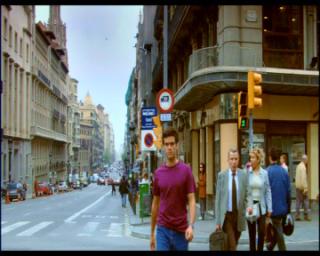 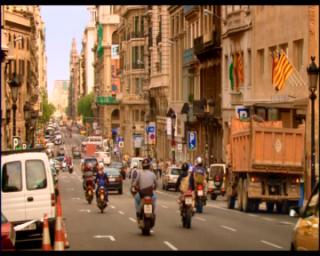 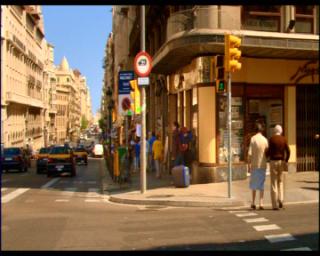
Via Laietana: Xavier (Romain Duris), a young French Economic Science student, has just arrived in Barcelona to study for a year on an Erasmus grant. Loaded down with suitcases and rucksacks he makes his way to his first home in the city from the Plaça Catalunya. Different shots show him walking along the Via Laietana, with a slightly disorientated and anxious expression because he is in a new, unfamiliar place.
|
Did you know that...
The film was shot on high-definition digital video, which was a very new technique in 2001. This system makes it possible to film more quickly and with a smaller crew. This meant that sequences like the one on the Via Laietana could be filmed with a crew of seven to eight people who transported all the necessary materials, including the digital camera on two trolleys which could be moved easily along the pavement.
The Via Laietana was the setting for a scene that didn’t make the final edit, in which the director uses the flash-forward technique. In this case, the scene showed Xavier’s life in Barcelona shortly after he had arrived in the city. |
The Barcelona of Erasmus Students
/
Via Laietana

